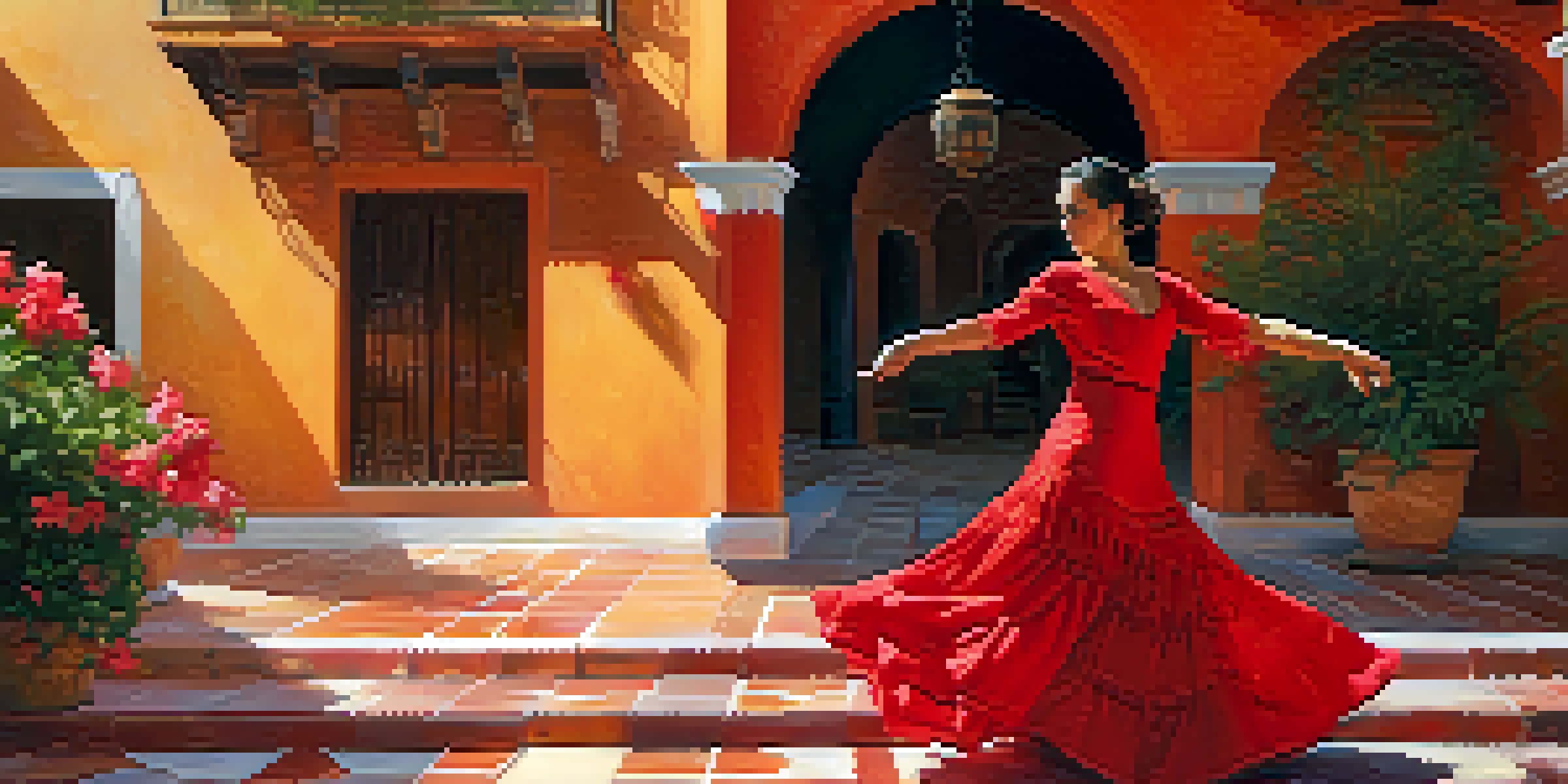The Healing Rhythms of Flamenco in Spanish Cultural Rituals

Understanding Flamenco: More Than Just Dance
Flamenco is often perceived as a vibrant dance form, but it's deeply rooted in emotional expression and cultural storytelling. Originating from the Andalusian region of Spain, flamenco encompasses singing, guitar playing, and rhythmic clapping, each element contributing to its rich tapestry. This art form serves as a medium for individuals to convey their life experiences, struggles, and joys, making it a powerful tool for emotional healing and connection.
Flamenco is the expression of a culture, a way of life that reflects the values and the emotions of the people.
The essence of flamenco lies in its ability to evoke strong feelings, allowing performers and audiences alike to experience catharsis. Imagine attending a flamenco performance where the dancer's movements tell a story of heartbreak or triumph; you can almost feel their emotions resonate within you. This shared experience creates a bond among participants, illustrating how flamenco can foster community and support during challenging times.
Moreover, flamenco is not just a performance; it is a ritual that integrates various aspects of Spanish culture, from festivals to family gatherings. Its presence in these social settings highlights the importance of connection and healing, as people come together to celebrate life's ups and downs through music and dance.
The Role of Rhythm in Emotional Healing
The rhythmic patterns in flamenco are not just for entertainment; they play a crucial role in emotional healing. Each 'palos' or style of flamenco has a distinct rhythm that can evoke different feelings. For example, the 'soleá' is often associated with deep sorrow, while the 'alegrías' brings about joy, showcasing how rhythm can mirror the complexity of human emotions.

When participants engage with these rhythms, whether through clapping, tapping their feet, or dancing, they often find a sense of release. This physical manifestation of feelings allows individuals to process emotions that might be difficult to articulate. It's similar to how one might feel lighter after a good cry; flamenco offers an avenue for emotional expression that is both liberating and transformative.
Flamenco as Emotional Expression
Flamenco is not just a dance; it serves as a powerful medium for emotional healing and storytelling.
Additionally, the communal aspect of flamenco enhances its healing properties. When people come together to share in the experience, they create a supportive environment where emotions can be safely expressed. This collective energy amplifies the healing effect, fostering feelings of belonging and understanding among participants.
Flamenco in Rituals: Weddings and Celebrations
Flamenco is a staple in many Spanish cultural rituals, particularly weddings and celebrations. At these gatherings, the music and dance elevate the atmosphere, creating an environment of joy and unity. Couples often choose flamenco as a way to honor their heritage while also inviting their loved ones to share in the experience, making the event even more memorable.
Through the dance, I can express what I cannot speak. It is a language of the heart.
During weddings, flamenco can serve as a form of storytelling, with dances that symbolize the journey of love and commitment. Each performance is often a blend of traditional and personal elements, ensuring that the dance resonates with the couple's unique story. This blend of tradition and personal expression not only entertains guests but also reinforces the emotional bonds that brought everyone together.
The celebratory nature of flamenco in these rituals highlights its role as a catalyst for joy and connection. As guests dance and engage with the rhythms, they find themselves immersed in a shared experience that strengthens relationships, making flamenco an integral part of Spanish celebrations.
Flamenco's Influence on Healing Spaces
In recent years, flamenco has found its way into various healing spaces, including therapy and wellness programs. Practitioners have recognized that the rhythmic and expressive nature of flamenco can assist individuals in processing emotions and overcoming personal challenges. By incorporating flamenco into their practices, therapists provide clients with a novel way to explore their feelings.
For example, some therapeutic programs use flamenco dance as a form of movement therapy, allowing participants to express emotions through physical movement. This approach can be particularly beneficial for those who struggle with verbal expression, as the movements and rhythms allow for a different form of communication. It’s like painting with emotions instead of words, providing a unique outlet for healing.
Rhythm's Healing Power
The distinct rhythms of flamenco facilitate emotional release and connection, enhancing the healing experience.
Moreover, the community aspect of flamenco creates a sense of belonging for participants in these healing spaces. As individuals come together to learn and share, they build connections that foster support and understanding. This communal healing experience highlights the importance of connection in the process of emotional recovery.
The Spiritual Dimensions of Flamenco
Flamenco also carries spiritual significance, often seen as a way to connect with one's inner self and the universe. Many performers describe their art as a form of meditation, where the rhythms and movements allow them to enter a state of flow. This spiritual aspect can lead to profound personal insights and a sense of peace that contributes to emotional healing.
The passion and intensity found in flamenco can evoke a transcendent experience for both performers and audiences. It's not uncommon for individuals to feel a deep connection to something greater than themselves while engaged in this art form. This sense of spirituality can help people navigate difficult emotions, offering solace and understanding.
Additionally, flamenco is often performed in sacred spaces, such as churches or during significant cultural events, enhancing its spiritual dimensions. These settings provide a backdrop that elevates the experience, allowing participants to immerse themselves fully in the healing power of music and dance.
Flamenco as a Tool for Cultural Identity
Flamenco serves as a powerful tool for cultural identity, especially among the Spanish diaspora. For many, participating in flamenco is a way to reconnect with their roots and honor their heritage. This connection can be incredibly healing, as it reinforces a sense of belonging and pride in one's cultural background.
In various communities, flamenco festivals and workshops provide opportunities for individuals to gather and celebrate their traditions. These events not only showcase the art form but also foster a deeper understanding of its cultural significance. By engaging with flamenco, individuals often find themselves embracing their identity, leading to personal growth and healing.
Cultural Identity through Flamenco
Engaging with flamenco helps individuals reconnect with their cultural roots, fostering a sense of belonging and pride.
Moreover, the act of preserving and passing down flamenco traditions helps strengthen community bonds. When generations come together to share their knowledge and experiences, it creates a sense of continuity and connection that is vital for emotional well-being. This cultural exchange through flamenco not only enriches individual lives but also fortifies the fabric of the community.
The Future of Flamenco in Healing Practices
As the world continues to evolve, so does the role of flamenco in healing practices. More wellness centers and therapists are beginning to recognize the benefits of incorporating flamenco into their programs. This shift reflects a growing understanding of the importance of emotional expression and community in the healing process.
Innovative approaches are emerging, blending traditional flamenco with contemporary therapeutic practices. For instance, some programs are experimenting with integrating flamenco into mindfulness and stress-reduction techniques. This fusion not only enhances the healing experience but also introduces flamenco to new audiences who may benefit from its therapeutic properties.

Looking ahead, the potential for flamenco to impact healing practices is vast. As more people discover its emotional and spiritual dimensions, flamenco can continue to serve as a bridge connecting individuals to their feelings, culture, and community, making it a timeless tool for healing.